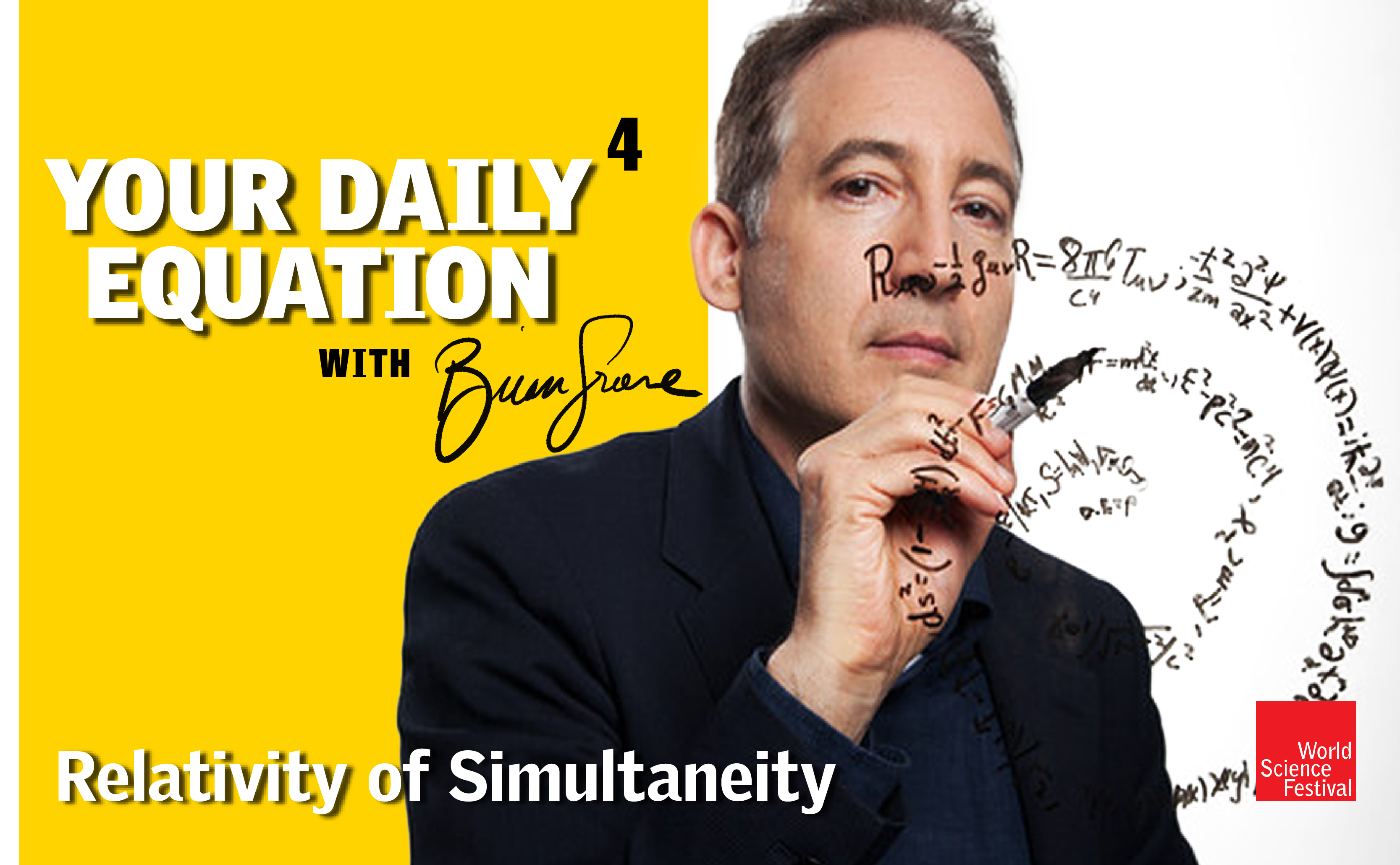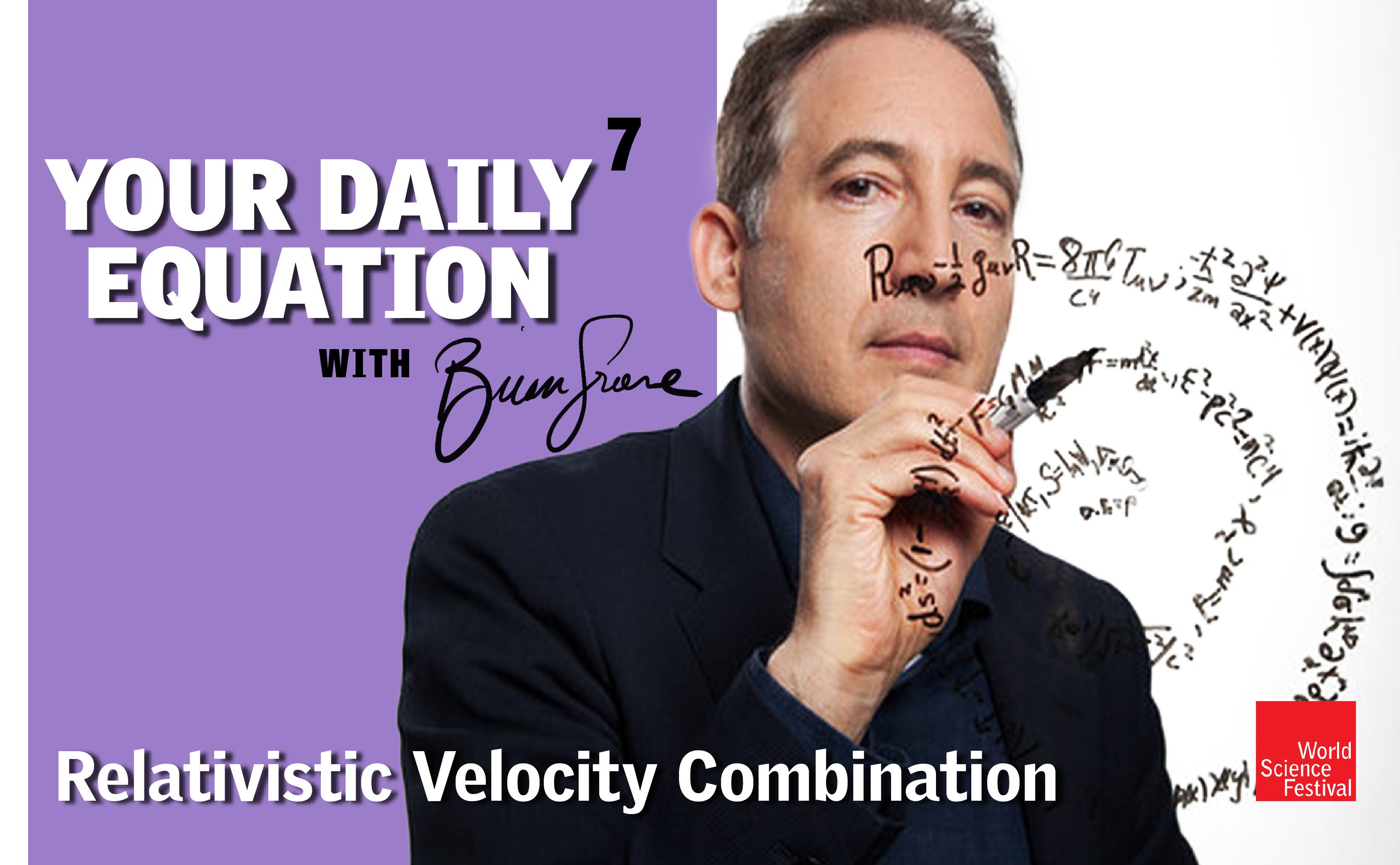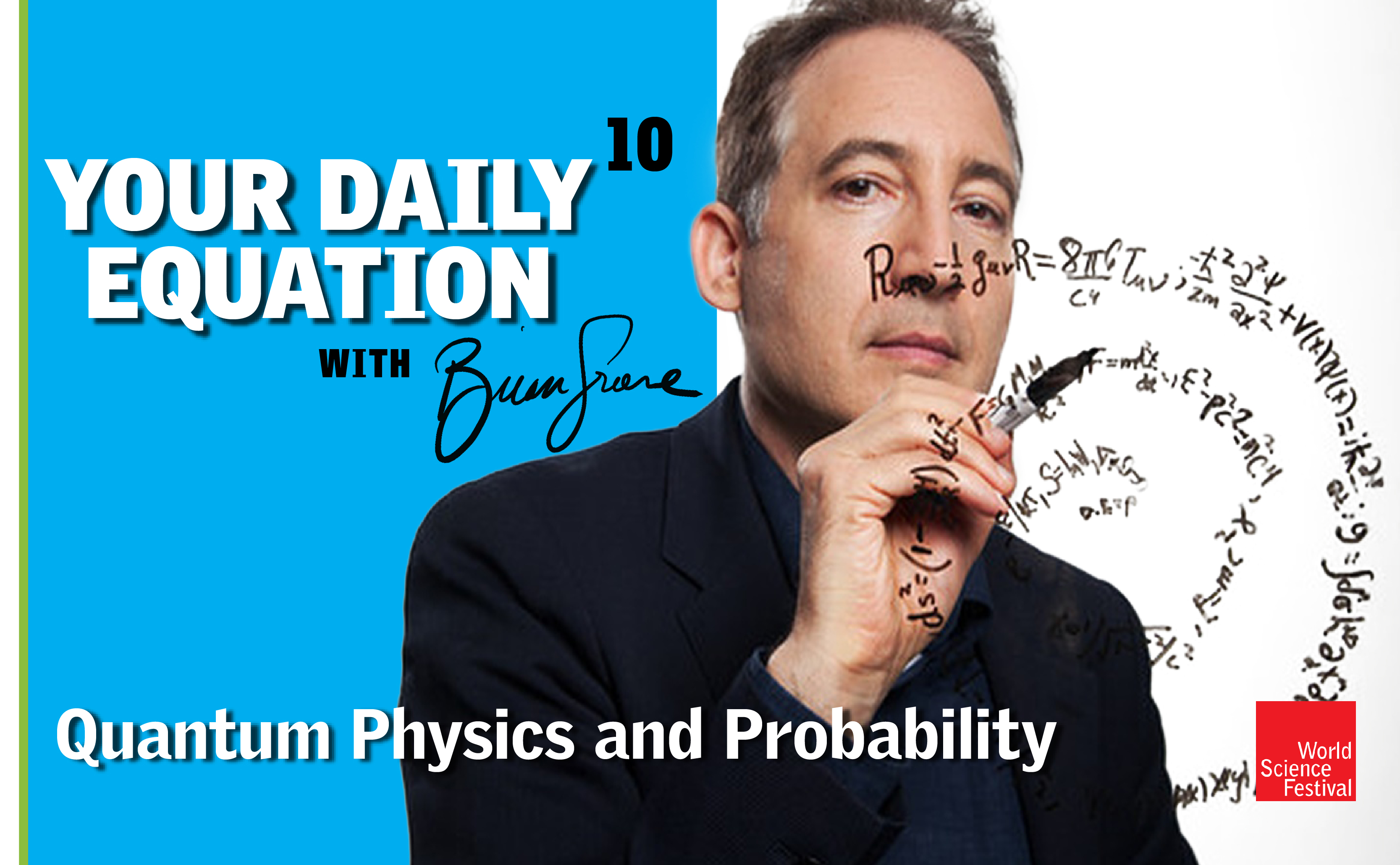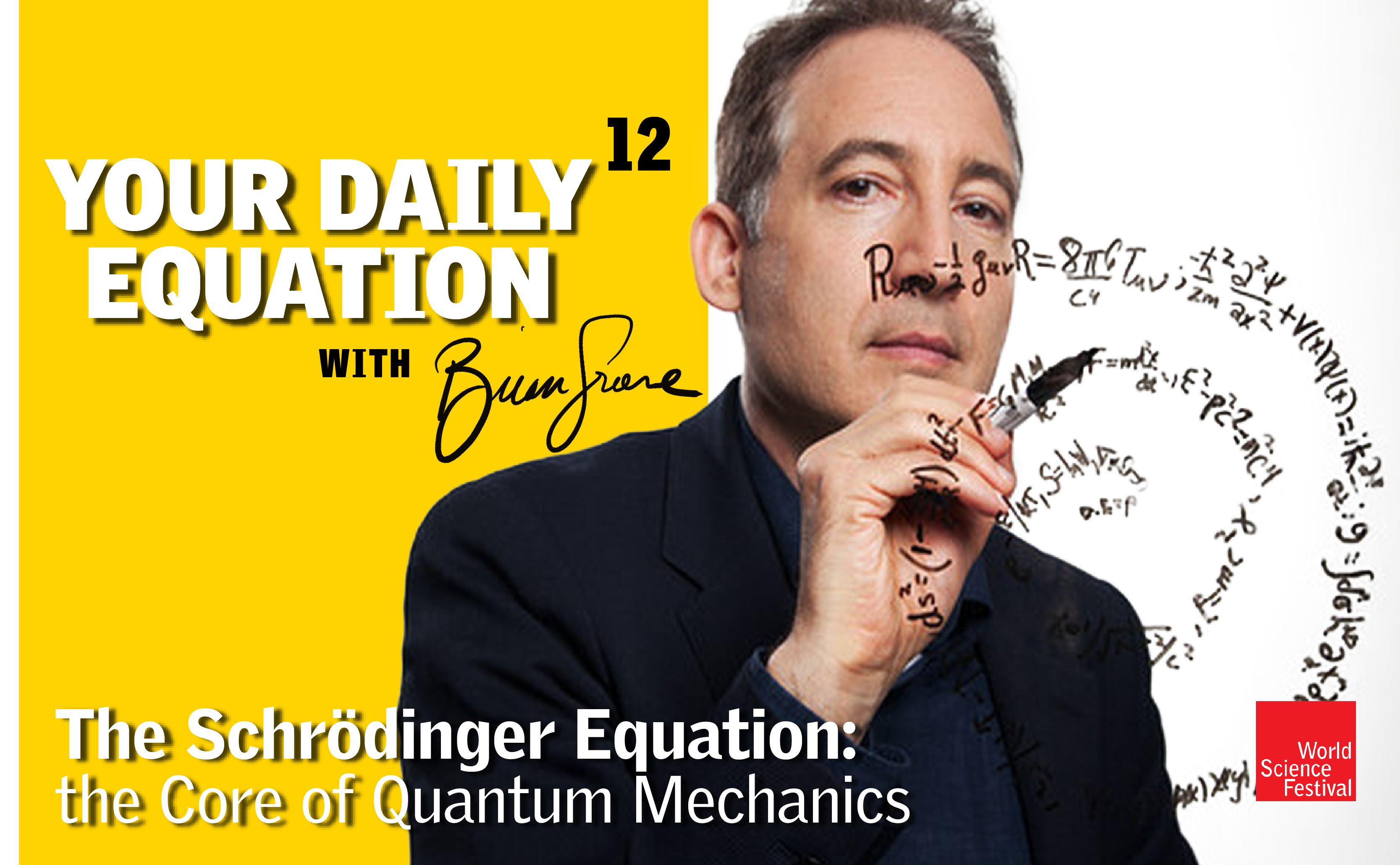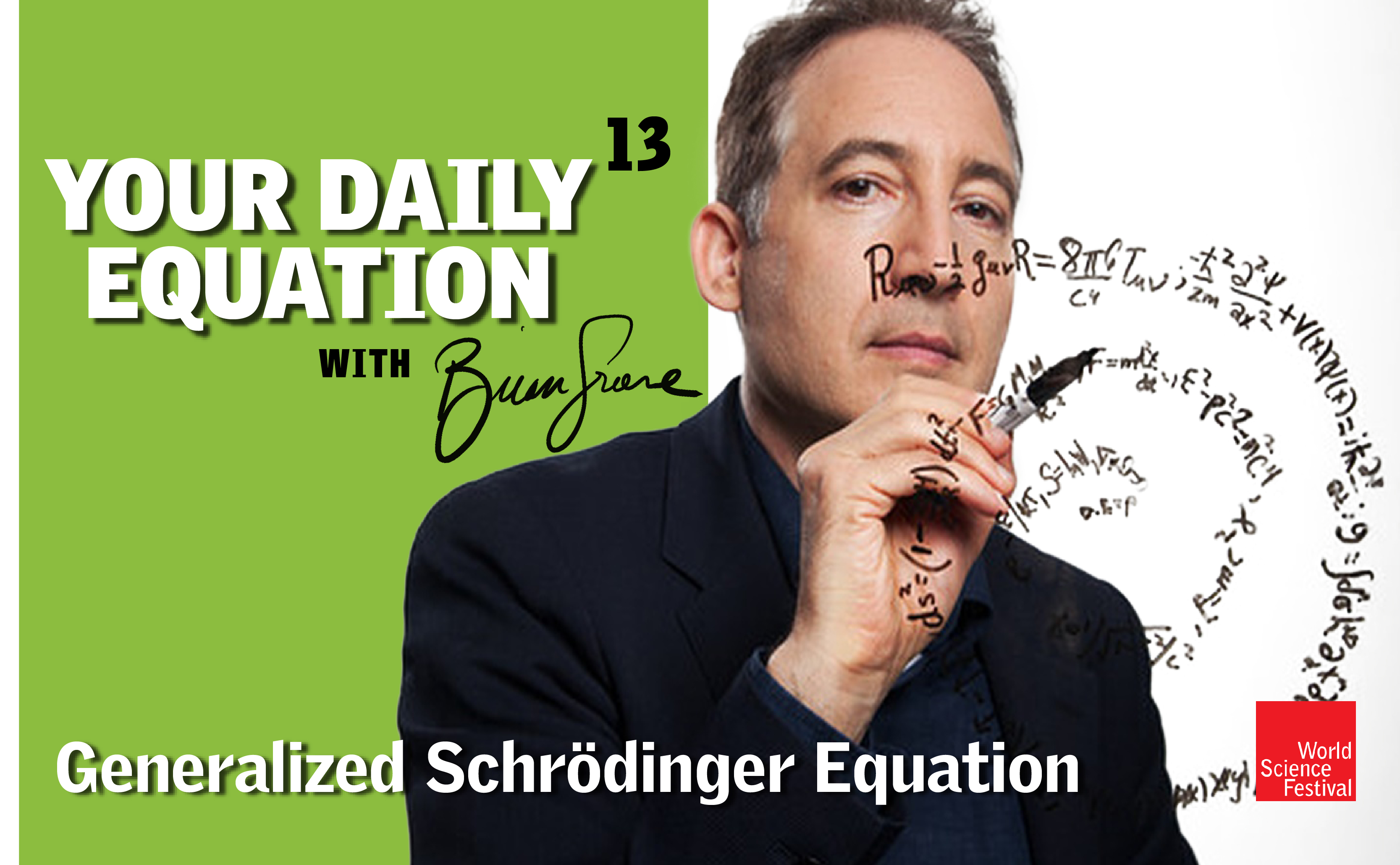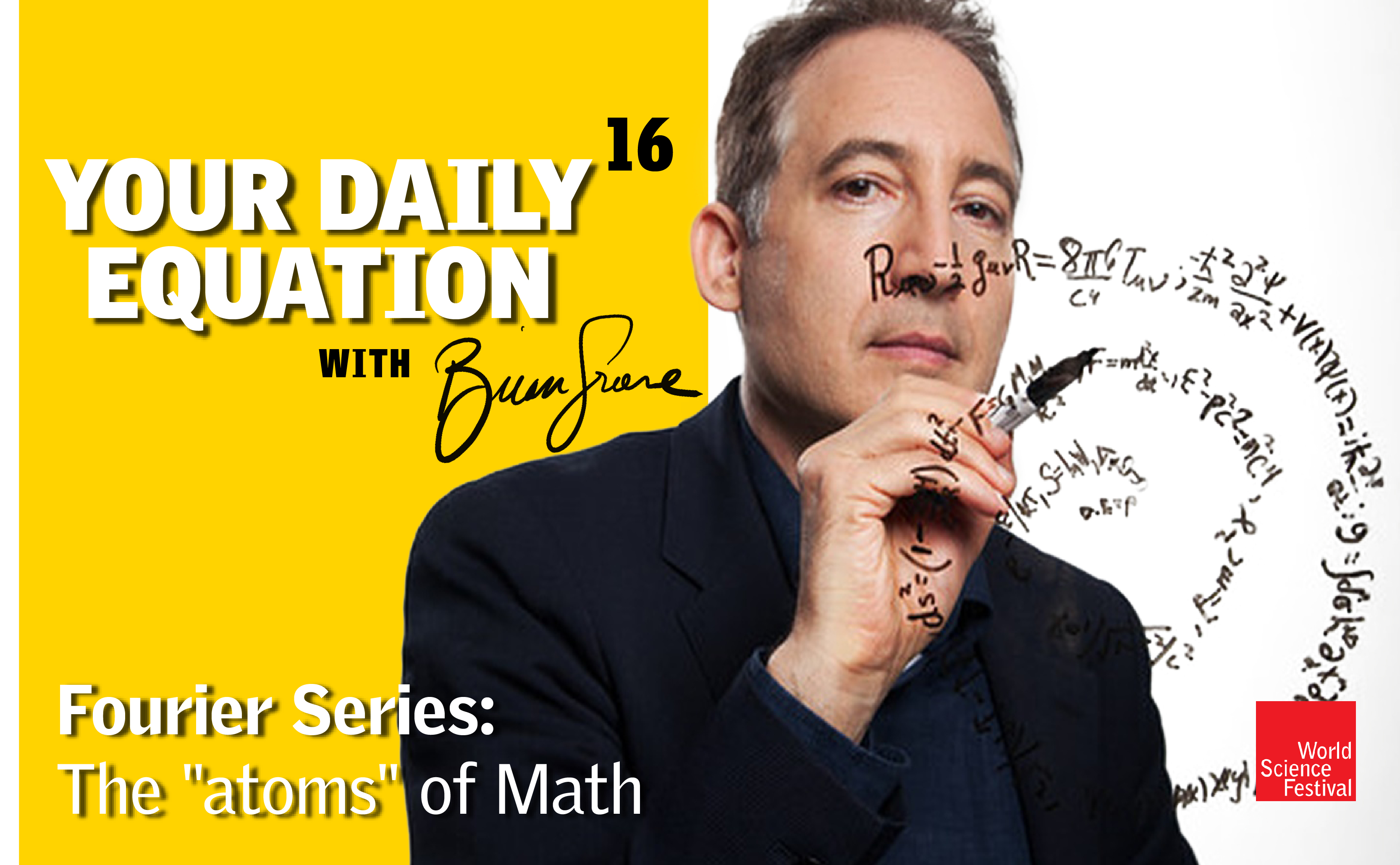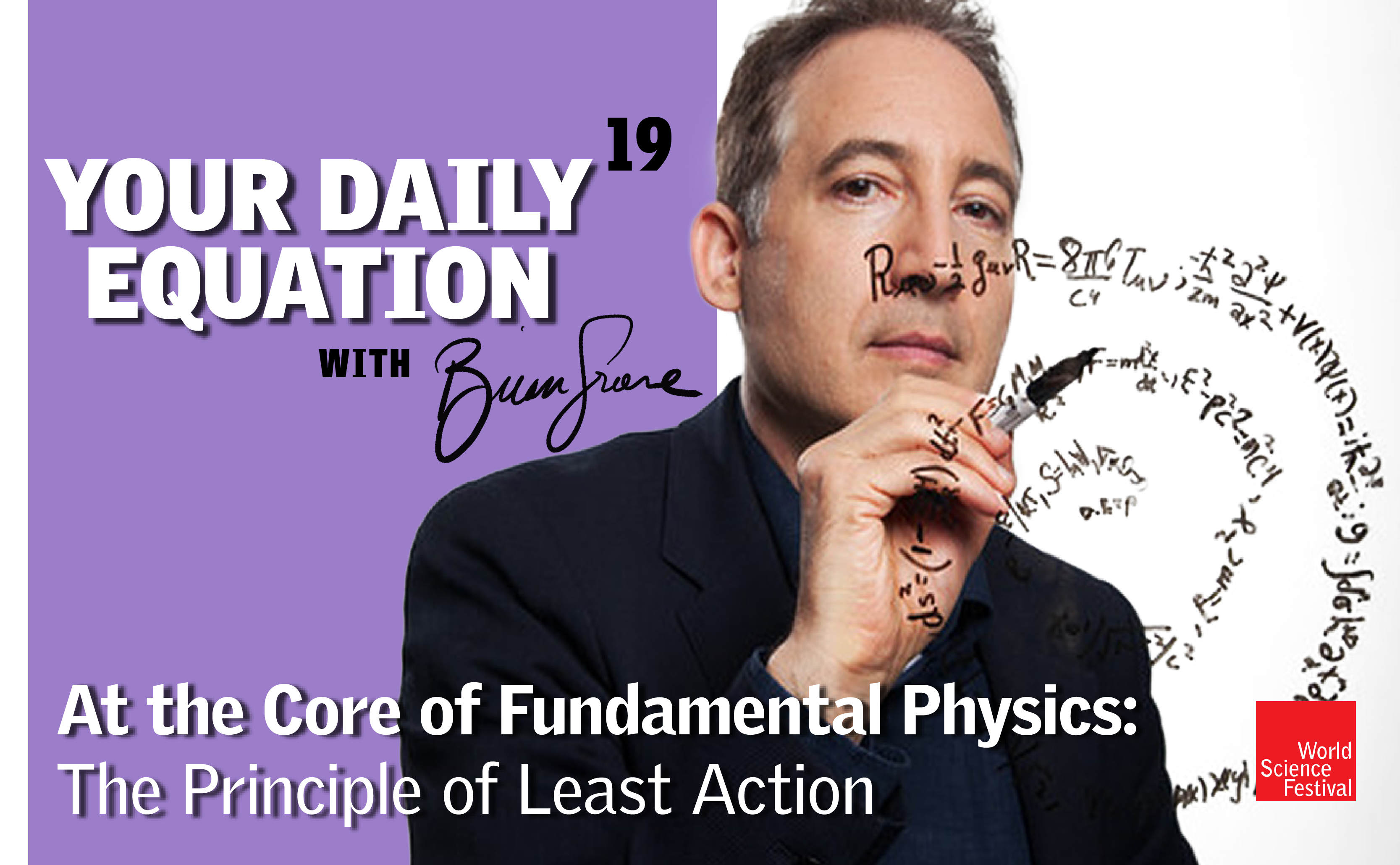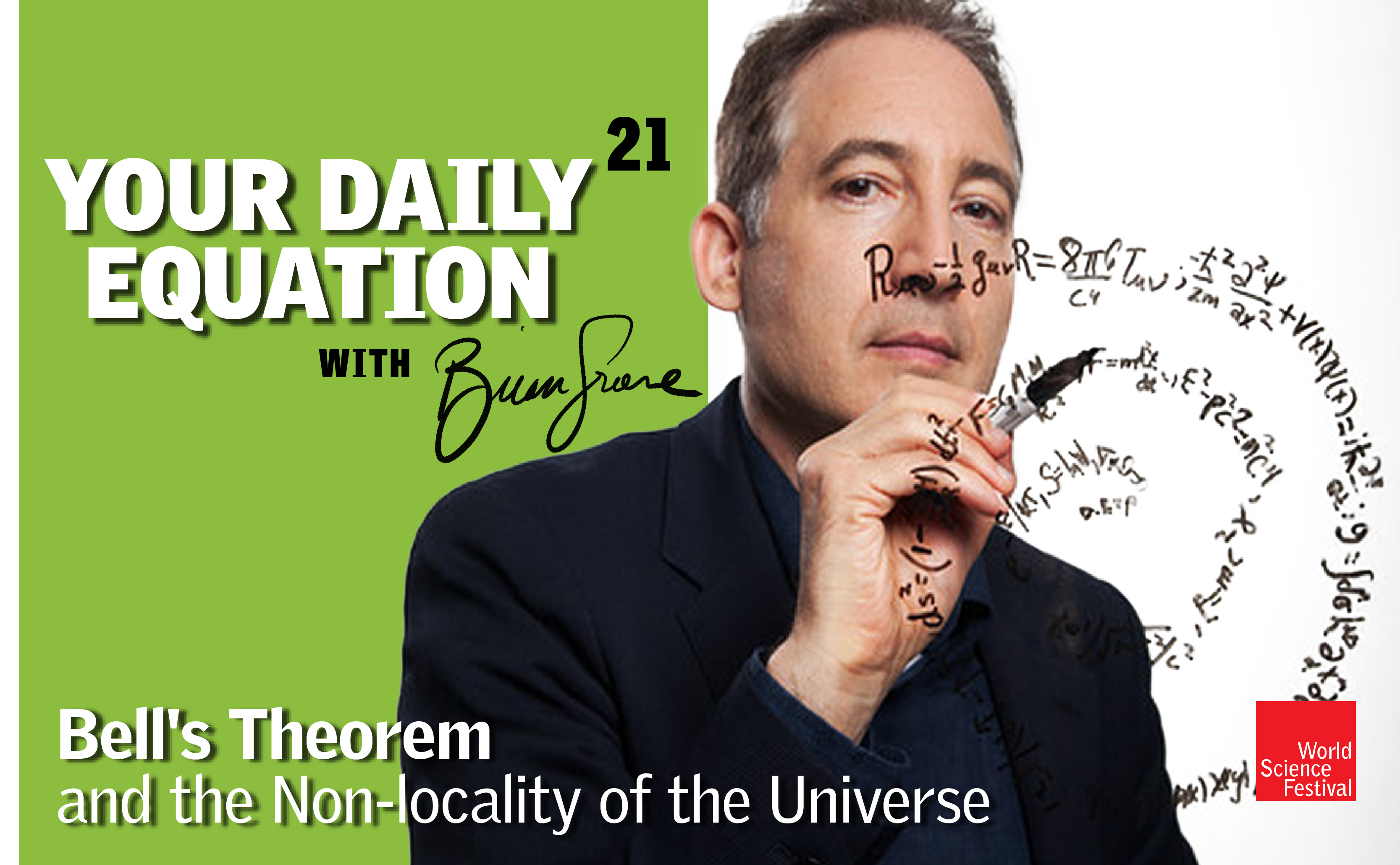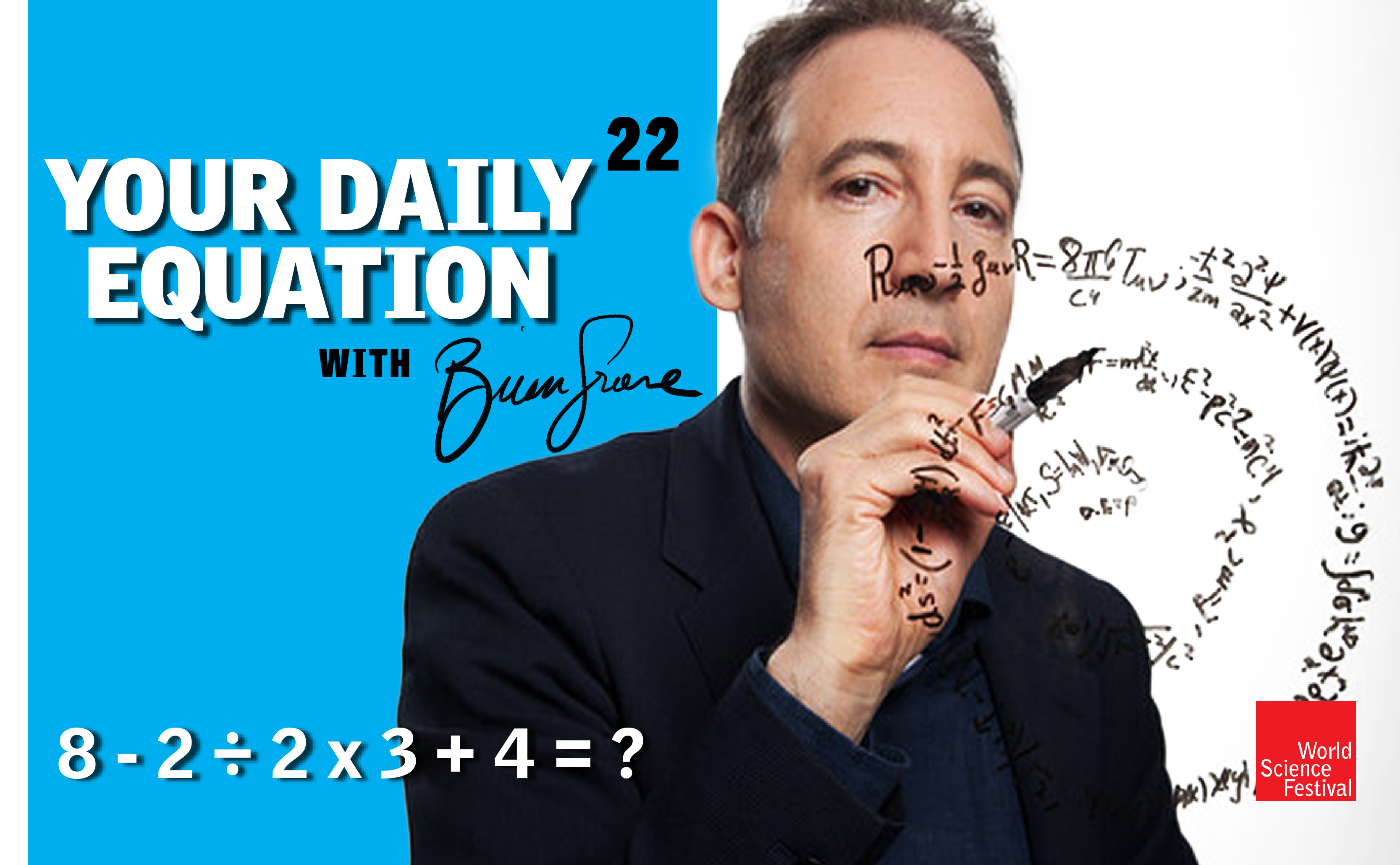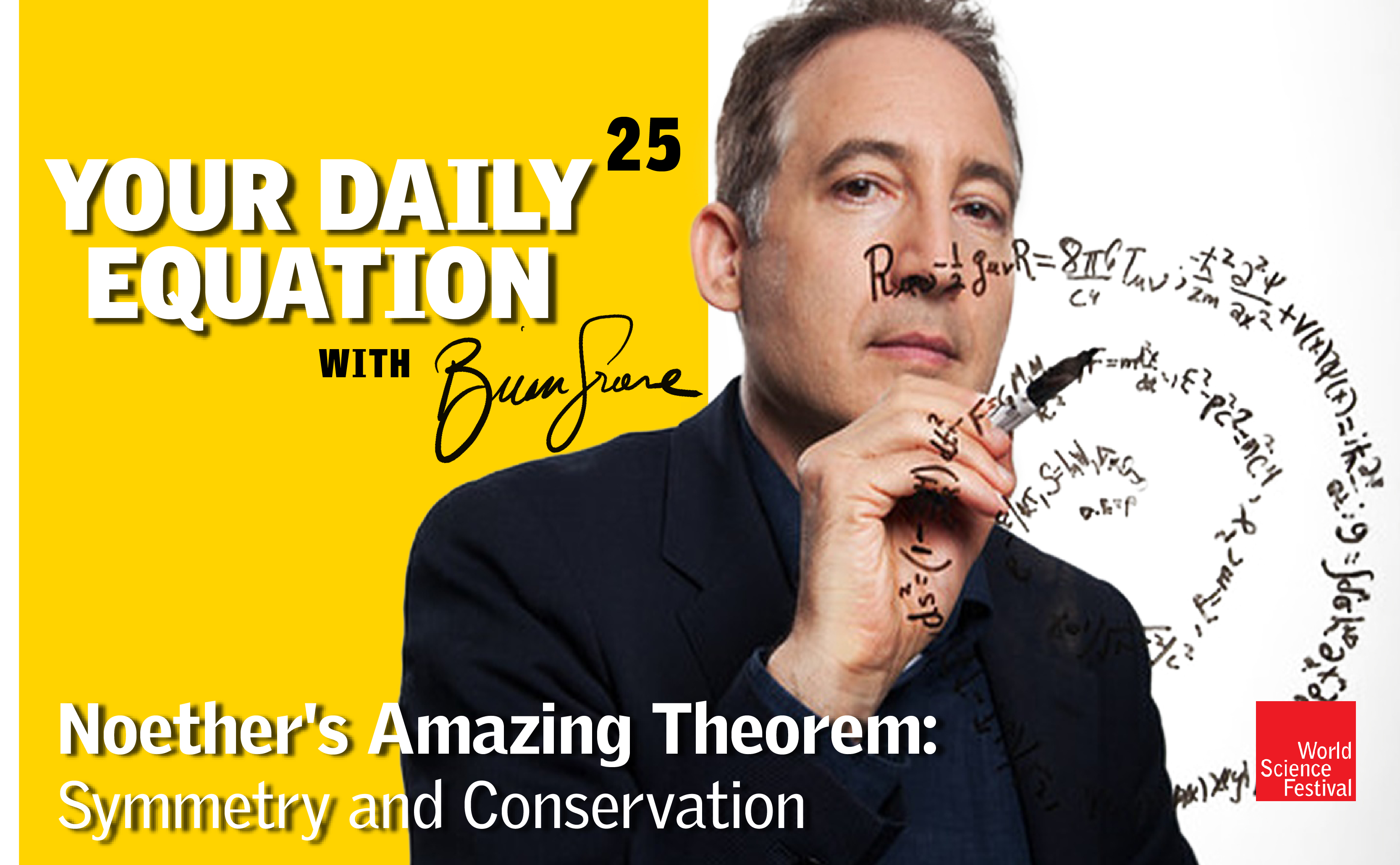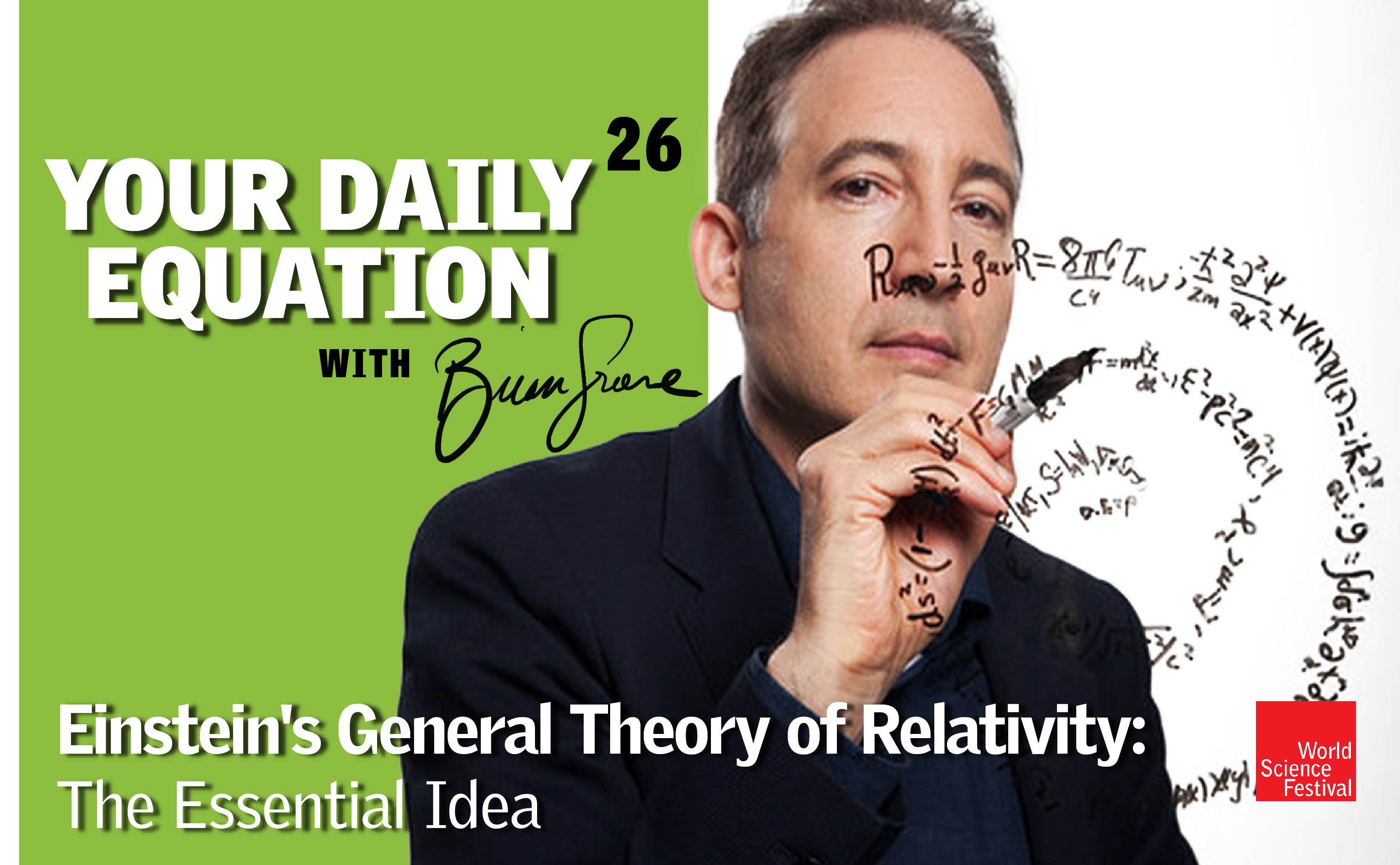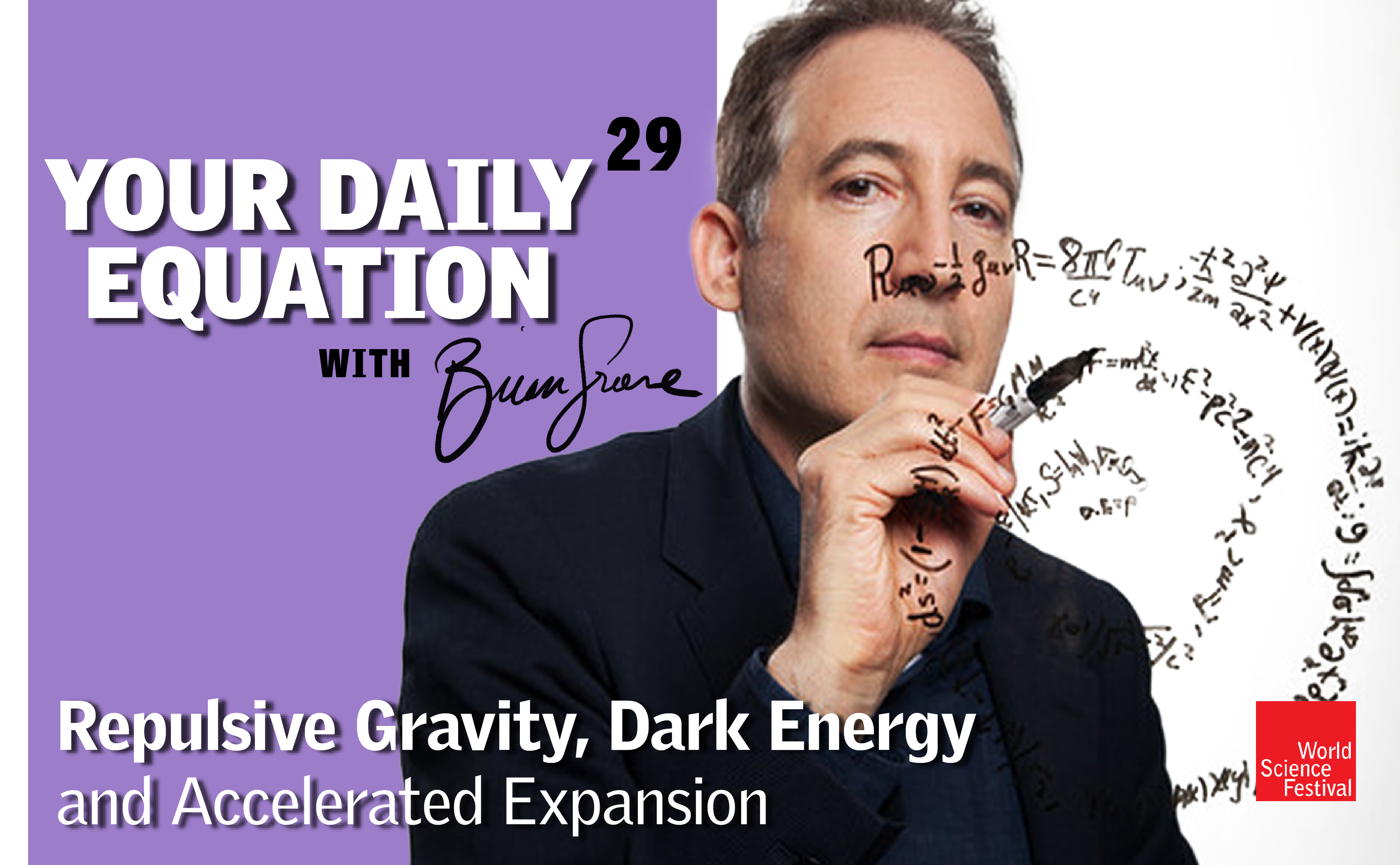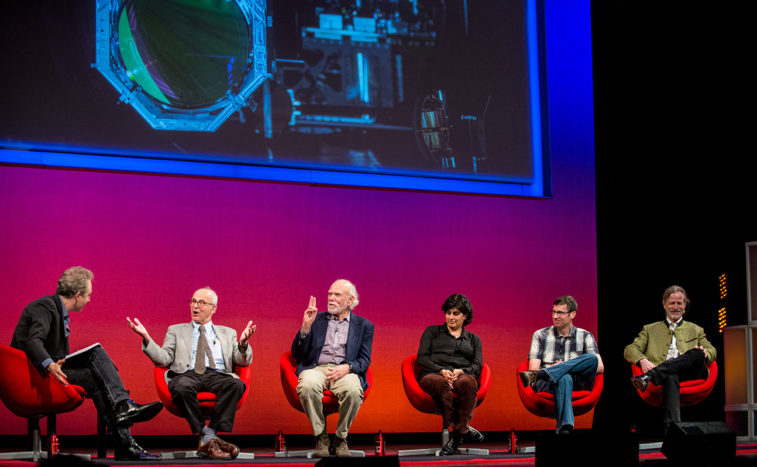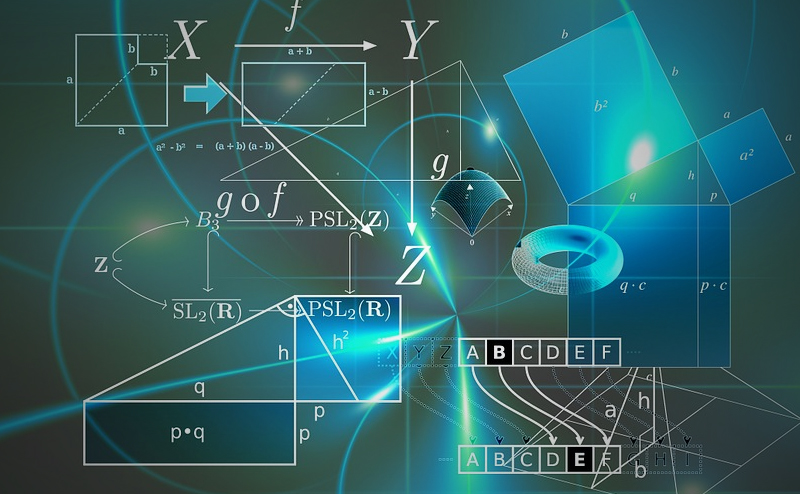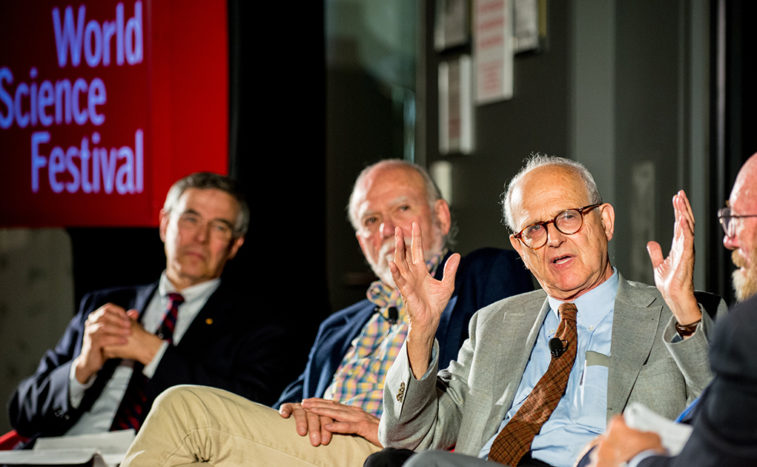570,889 views | 00:44:44
Join us for #YourDailyEquation with Brian Greene. Every Mon - Fri at 3pm EDT, Brian Greene will offer brief and breezy discussions of pivotal equations. Even if your math is a bit rusty, tune in for accessible and exciting stories of nature and numbers that will allow you to see the universe in a new way. Episode 28 #YourDailyEquation: Shortly after Einstein published his new theory of gravity, his general theory of relativity, researchers realized that it predicted that the universe should expanding--a prediction subsequently confirmed by astronomical observations. And if it is expanding today, then running the cosmic film back toward the beginning suggests a highly dense and energetic starting point--the big bang. Join Brian Greene for a visual explanation of the essential ideas as well as an introduction to the underlying math that yields these conclusions.Learn More
Speaker 1:
Hey everyone. Welcome to this next episode of Your Daily Equation. I hope you’re doing well. It is cold and rainy where I am at the moment. Maybe where you are the weather is better. But at least it’s pretty outside, I can’t complain of course about the context in which I find myself these days. And what I’d like to do today is focus upon the big bang and the notion that space is expanding.
These are ideas that emerged in the early part of the 20th century after Albert Einstein wrote down his equations of the general theory of relativity. So I’ll take you through a little bit of the history of thinking along those lines and then I’ll show you a bit of the mathematics that leads to these conclusions. I won’t spell out every last detail, maybe in subsequent episodes I will.
I just really want to give you a feel for how it can be that equations can tell you something like the universe is expanding or contracting, or that there should have been a big bang at time zero. Where in the mathematics can you find these kinds of conclusions? All right. So let me begin with just a little bit of the history of these ideas. So let may bring up some stuff here on the screen. Good. Okay.
So this guy over here, Georges Lemaitre may be a familiar name to you, but he’s not necessarily a household name, or actually it’s not a household name, that I’m pretty certain about. He was a Belgian priest who had the unusual distinction of earning a PhD in physics from MIT, and also obviously being a priest. And those are usually fields that we envision as being whatever, antagonist, at odds with each other. They, by no means, need to be. Case in point right here.
And so it was quite natural that when Lemaitre learned that Einstein had come up with this new description of the force of gravity, and again, the force of gravity is the force that is most relevant over the large scales of the universe, right? So naturally, if you are interested in the big questions of existence, you want to apply Einstein’s new insight to the biggest possible example, which of course is the universe as a whole. And that’s what Lemaitre did.
And he came to the conclusion, and I’ll show you more or less why he came to that conclusion. He came to the inclusion that the universe could not be static, right? The going philosophical prejudice at the time was that on the largest of scales the universe was fixed, eternal, static, unchanging, right? There obviously is change in the local environment, right? You see the moon moving, you see the sun moving, but you interpret it as the earth in orbit around the sun. So there’s obviously change in the local environment.
But the view was that on average, if you average that out over sufficiently large scales, that there would be no overall change, right? I mean, I don’t have my Earl Grey here today, so I have to do a thought experiment. But as you’ve seen, when I have my Earl Grey and my soy milk, it’s got this muddy brown color and it looks static and unchanging. If you were to go sufficiently deep into that cup of Earl Grey, you’d find that all the molecules of water, tea, whatever, they’re all bouncing around.
So there’s a lot of motion, a lot of change happening on small scales within the cup of tea. But when you average it out on the scale of a cup, it doesn’t look like anything is happening at all. So the view was that the local motion, motion of moons, planets, things in the local environment, that’s like the motion of the molecules inside the cup of tea. But average it out over sufficiently large scales, and just like the cup of tea, you will find that on sufficiently large scales, the universe is unchanging.
That was the prevailing view. So when Lemaitre came to the startling conclusion that Einstein’s math, when applied to the entire universe, says the fabric of space is stretching or contracting but not simply staying put, that was going against the grain of most people’s intuition, most people’s expectation. So Lemaitre brought this idea to Einstein. They spoke, I believe this is the 1927 Solvay Conference.
And Einstein’s response is a famous one. I think I mentioned it in a previous episode, Einstein said to Lemaitre something like, “Your calculations are correct, but your physics is abominable.” And what he was basically saying is, sure you can do calculations using various equations, in this case Einstein’s own equations, but it’s not the case that every calculation that you do is necessarily relevant to reality.
Einstein was saying, “You got to have sort of an artist’s intuition to figure out which of the configurations and combinations and calculations that you do with the equations is actually truly relevant to the physical world.” Now, the reason why Einstein could say that Lemaitre’s calculations were correct is more or less because Einstein had already seen those calculations early.
Number one, Einstein did his own version of applying his equations to the entire universe, I’ll make reference to that at the end. But in particular, this guy over here, Alexander Friedmann, Russian physicist, he, some years earlier had actually written a paper showing that Einstein’s equations apply that the universe is say stretching or contracting. And at that time, Einstein himself wrote a little response to Friedmann’s paper where he said that Friedmann’s calculations were wrong.
Now, you can imagine it’s pretty tough when Albert Einstein grades your paper and says that the calculations are wrong, but Friedmann was no pushover. He knew that he was right then he stayed with it and he wrote to Einstein a letter establishing in his mind that the calculations were correct. Einstein, I believe was on a trip to Japan at the time. So he didn’t see the letter when it first arrived, but Friedmann implored a friend of Einstein’s to really get Einstein to read the letter.
I’m pretty sure this history is correct, I’m going completely by memory here. I hope it’s real memory. And Einstein did read the letter and finally came to the conclusion that Einstein had himself made a mistake and that it was Friedmann’s calculations that were correct. But nevertheless, that didn’t change Einstein’s perspective that this notion let’s say of an expanding universe, a universe that was changing over time, he still did not think that that was relevant to reality, right?
Again, “Okay,” he says, “the math is all right, but it’s not relevant to the actual structure of the world.” What really changed Einstein’s perspective were observations, observations by Edwin Hubble. Edwin Hubble use the powerful telescope at Mount Wilson Observatory to conclude that the distant galaxies are not staying put, the distant galaxies are all rushing away. And that outward motion of all the galaxies was clear evidence that the universe is not static.
And you can even see a little bit of some of Hubble’s data. I think I have it over here. So this graph over here shows the relationship between the distance that a galaxy is from us and the speed with which it is receding from us. And you see that there’s this nice curve here, which basically is telling us that the farther away a galaxy is, the quicker it is rushing away from us. So it’s speed of recession is proportional to its distance.
And it turns out, and I’ll give you a little visual in half a second, that is exactly the relationship that you would expect if space itself is expanding. If space itself is expanding then the speed with which two points in space move apart due to the swelling of space is proportional to their separation. And I’ll give you a little example right now. It’s the familiar one that you’ve probably seen a million times, but it’s not perfect, but it’s a pretty good way of thinking about this notion of how it can be that every object can rush away from every other.
That’s sort of a strange idea if you think about it. You think that some are rushing away, they’re heading toward others. No, they’re all rushing away from each other. And more over the speed of recession is proportional to the distance. This helps you get your mind around that. What is the analogy? Of course, it is the famous balloon analogy where we imagine that the surface of a balloon is the entirety of the universe.
Just the surface, the rubber part, the stretchy part of the balloon. That is the analogy. Imagine that that is all there is, that is the entirety of the universe. And you imagine that you have galaxies that are drawn on the surface of this balloon. And as the balloon stretches, you can see how the galaxies move relative to one another. So let me just show you, so here it is. So we have this balloon, you see the galaxies over there and the idea is as you blow air into the balloon, everything moves away from everything else.
So I can even make that a little bit more precise by putting a little grid on the balloon. So you see this grid has a unit of one unit of separation between the grid lines. And now let’s see what happens when we blow air in. And what I want you to focus your attention on, the two lower galaxies are one unit apart, the two galaxies right above it are two units apart. And those two galaxies at the upper edge of the grid, they’re three units apart. So one unit, two units, three units.
Let’s now blow the balloon up, stretch it some so it gets larger. There it goes. Now, the galaxies that were one unit apart are now two units apart. The galaxies that were two units apart are now four units apart. And the upper two galaxies that were three units apart are now two plus two plus two, are now six units apart. So you see that the speed with which the galaxies receded is proportional to their initial distance.
Because to go from one unit to two, that’s a certain speed. But to go from two units to four, it’s got to be double the speed. This all happens in the same period of time as the balloon stretches to go from three units apart to six units apart in the same period of time, you have to have three times the velocity of the two lower galaxies. So there you see that the speed of recession is proportional to the separation, is proportional to the distance.
So we can compare them right here and you see what I was talking about. You went from one to two, you went from two to four and the upper two galaxies went from three to six. So this gave substantial evidence that the universe is expanding, it comes out of Einstein’s mathematics. The calculations are correct, but the physics is not abominable when you have observations that confirm the mathematical prediction.
So this turned Einstein around in an instant. He quickly came to the conclusion that this picture of the universe was correct. And he kind of slapped himself metaphorically in the forehead for not himself coming to this conclusion a decade earlier, because Einstein was really in the position to predict one of the most profound insights about the nature of reality that space is expanding. He could have made that prediction something like a dozen years before it was observed.
But be that as it may, what really matters is that we gain insight into the nature of the world. And through Einstein’s mathematics in the hands of Friedmann and Lemaitre confirmed through the observations of Hubble, we have this picture of the expanding universe. Now, if the universe is currently expanding, well then it doesn’t take a rocket scientist to imagine winding that cosmic film in reverse. Everything today rushing apart, go back in time, everything was closer and closer together.
And in this model of the universe, that means that everything would be back on top of one another at time zero. That is the big bang. And I’ll show you a picture of that in just a moment. But I do want to address a couple of quick things about the balloon metaphor. Number one, people often say, “Okay, if the universe is expanding, where’s the center? Where’s the center of the expansion?”
Now, the balloon has a center, of course. But it’s not on the surface of the balloon, it’s inside the balloon. But this metaphor requires that we think about the entirety of reality to just be the surface of the balloon. The inside of the balloon is not a point in reality in using this metaphor. And you see that as the surface stretches, there’s no center. Every galaxy, every point on the balloon is moving away from every other point on the balloon. There’s no special location on the balloon surface.
Now, it’s not hard to capture that idea in your mind when it comes to the balloon, it’s harder to then extrapolate from this metaphor to the entirety of space. But I really encourage you to do so because we believe that as in this metaphor, there is no center to the universe. Every location, every galaxy is moving away from every other galaxy. There’s no preferred spot from which everything is rushing apart. It’s not really like an explosion in a preexisting space in which there really is a center where the explosion took place.
There’s no preexisting space in this view of cosmology, right? As space expands, you get more space. It’s not that the space was already there. And that’s the second point that I really want to make because people often say, “Okay, if the universe is expanding, tell me what it’s expanding into?” And again, the intuition is clear even with the balloon, the balloon expands into our preexisting space. But for the balloon metaphor to really grab hold of you fully again, imagine that the surface of the balloon represents the entirety of the universe.
And so when the balloon expands, it’s not expanding into a preexisting space, because the preexisting space is not on the surface of the balloon, which is meant to be in this analogy the entirety of reality. So what does happen is as the balloon stretches, there’s more space because the balloon is stretched. It’s bigger. There’s more surface area on the balloon because of the stretching.
Similarly, there’s more volume in our universe because of space stretching. Space is not expanding into previously unchartered territory, it’s expanding and thereby creating the new space that it then contains. So those are two seller points that I hope that clarifies a little bit. But now let me conclude the story, this visual version of cosmology by showing you what we would envision then for the big bang.
So again, run the cosmic film back to the beginning, imagine all of space. Again, it’s very hard to picture this, all of space in this finite case is compressed to a single point. Maybe that’s a third caveat, I should say. So in this example, clearly the balloon has a finite size. So it’s imagining that the universe has an overall finite volume. And therefore if you wind the film back to the beginning, finding it smaller, smaller and smaller. Ultimately it goes down to effectively infinitesimal or zero volume.
A point I’ve made in another episode, but let me just reemphasize it here. If you had a different model for a space, an infinite model, imagine that we had the rubber that makes up the balloon surface, but it is stretched infinitely far in all directions, infinitely far. Then as you stretched it, again, you’d have points receiving from each other and the speed of recession would again be proportional to their initial separation.
But if it was infinitely big, not finite like the sphere, then as you say, wind the film backward and have things go smaller and smaller and smaller, it would still be infinite in size. Because if you cut infinity down by a factor two say, infinity over two is still infinity. Cut infinity down by a factor of a thousand, still infinite. So that’s a key difference between the finite shaped version that the balloon brings to mind and this harder to picture but perfectly viable infinite version of space.
So when I’m talking about the big bang right now, I’m going to really use the image of a finite volume. So imagine that all of space is compressed into a little tiny nugget. It’s not existing in a preexisting space. My visual may make it look like it’s existing in a preexisting space because I don’t know how else to represent these kind of unfamiliar ideas visually, but here then would be what the big bang would be like.
Everything’s compressed, undergoes is rapid swelling, and as the space gets larger and larger, all of the hot initial primordial plasma spreads ever more thinly, cools down and structures like stars and galaxies can emerge. So that’s the basic image if you will, of expanding space, wind the film back, takes you to this notion of a big bang.
Now, if it was the infinite version of space, not the finite one, then it would basically be infinitely compressed at an infinity of locations, not at one location and this big bang would be this rapid swelling of the entirety of this infinite expanse, which is a different image to have in mind. But as far as the things that we have access to would be very similar to this picture, because we don’t have access to things that are infinitely far away, ever. It would take an infinite amount of time for the light from those locations to reach us.
We only ever have access to a finite volume and therefore the image that I gave you is a pretty good one even if the entirety of reality were to be infinite. So that’s the visual version that I want to finish up with here, is to just give you some of the basic mathematics behind what we’re talking about here. So I want to again go through every last detail, but I do want you to at least see how equations can lead you to these kinds of ideas of an expanding universe.
We’re going to run out of room so I’ll just write small. An expanding universe and this idea of the big bang. So how does this go? Well, you may recall from an earlier episode or from your own knowledge, or if this is completely new, I will just tell you from the outset that Einstein gave us, in his general theory of relativity and equation, which basically relates the geometry of the universe, so the geometry of space time.
He relates that through a very precise equation to the matter, energy and also momentum, pressure, won’t write it all down here, but the stuff that’s within space time itself. And by geometry of space time, what I mean there is things like the curvature of space time and the size, in some sense the shape of space time. So all of this is being related in a precise way to the matter and energy that is within space time.
And let me just record that equation for you. So it’s Rμ₀ minus a half Gμ₀R equals 8πG over C to the fourth, I won’t put the C, I’ll assume that C is equal to one in the units that we’re using, times Tμ₀. And the idea is that this left hand side is a mathematically precise way to talk about the curvature of space time. And this Tμ₀, stress energy tensor is a precise way to talk about the mass and energy within a region of space time.
So in principle, this is all that we need. But let me just spell out a couple of the important steps and important ingredients that go on here. So first of all, when we talk about curvature, you may recall, in fact, I think I’ve got a little… yeah, I can bring this up here. We had a means of talking about curvature in terms of something called gamma connection. Again this an earlier episode, you don’t need the details. I’ll just show you the idea here.
So the diagnostic that we have for curvature is you take a vector on a shape and you parallel move it, so called parallel transport it around a curve that lives in that shape. And the rule, the methodology for parallel transporting the vector around requires that you introduce this thing called a connection that connects one location to another, allowing it to slide it around.
So when you’re in a simple example, like here the two dimensional plane. And if you choose the connection to be the rule of parallel motion that we all learned in high school, in high school what did we learn? You just slide the vector so that it points in the same darn direction. That’s the rule. It’s a very simple rule, but it still is a rule. It’s an arbitrary rule, but it’s the natural one so we don’t even question it when we’re learning in school.
But indeed if we use that particular rule, then indeed, if we move the pink vector around the plane, when it returns to its starting location, it’s going to point in exactly the same direction as it was pointing when we started. Now, you could choose other rules on the plane. You could make a point in a different direction, but let’s keep this as our prototype of the notion of the plane not having any curvature being aligned with this particular notion of parallel motion.
For a sphere it’s quite different. As a sphere here, you see you can start with a vector at one given location, and you can now slide that vector around a loop just as we did on the plane. And we’re using a very simple definition of sliding around, keeping its angle with respect to the path that it’s moving on fixed. But look, when you come back to the starting point on the sphere, using that rule for parallel motion, the vector does not point in the same direction as the original.
You have a discrepancy in the direction which they’re pointing and that’s our diagnostic for curvature. That’s what we mean by curvature. And let me just head back over here, is this up? Good. So there this is this guy gamma that gives you the rule for sliding things around, and it’s really up to you to choose gamma. Now, some of you were asking some questions in earlier episode, is it arbitrary? Can you choose whatever you want?
Well, there are some technical details, but basically in any given coordinate patch, yeah, you can choose any gamma that you like. It’s up to you to choose the definition of parallel motion. However, if you have the notion of a metric, and that’s what this guy is over here, this is what is known as a metric. It’s a distance function. It allows you to measure distances on whatever shape, whatever surface, whatever manifold you are dealing with.
If you have a metric, then there is a unique choice of parallel motion connection that is compatible with that metric in the sense that the lengths of vectors will not change as you move them parallel to themselves. And that’s important because that’s going to pick out a specific choice of parallel motion, a specific version of therefore curvature.
So quickly, what do I mean by a metric? It’s something that you all know about from the Pythagorean theorem, right? According to the Pythagorean theorem, if you’re in a nice flat space and you go say ΔX this direction, and you go ΔY this direction. And then if you’re interested to know the distance that you’ve traveled from your starting point to your ending point, Pythagorean tells us that this distance, well, let me do the square of the distance so I don’t have to write square roots.
The square of that distance is ΔX squared plus ΔY squared. Now that’s very specific to a nice flat surface like the two dimensional plane. If you have a curved surface… Come on, don’t do that to me Notability. There we go. So we have some curved surface like that. And imagine then you go say ΔX this direction and ΔY this direction and then you’re interested in that curved distance from your starting point to your ending location.
That’s a pretty ugly looking trajectory. Let me do something like… that’s a little bit better. What is that distance in terms of ΔX and ΔY? And in general, it’s not ΔX squared plus ΔY squared. In general, it’s something of the form. Let me just sketch it down here. A number times say ΔX squared, another number times ΔY squared, plus another number still times a cross term. So that’s the general form of the distance relation on say this curved surface from the initial to the final point.
And these numbers A, B and C, they define what’s known as the metric on this curve space. And these numbers that I have over here, let me use a different color to pull that out. These numbers that I have over here are indeed a matrix that’s got two indices, μ and ν. μ, ν run from one to the dimension of the space in space time, it’s from one to four, three dimensions of space and one of time.
So μ and ν go from one to four. Get rid of that extraneous fellow over there. They are the analog of these numbers that I have over here, the A, the B and the C in this little example. But since space time itself can be curved and you’ve got four, not two, not just a ΔX and a ΔY, you’ve also got a ΔZ and a ΔT. So you’ve got four in there. So you therefore have four by four possibilities where you’ve got, say ΔT times ΔX, and ΔX times ΔY and ΔZ times ΔX.
You’ve got 16 possibilities, it’s actually symmetric so there’re 10 numbers in there. And these are the 10 numbers that give the shape of space time. So now, how does the procedure go? I told you that given a metric, there is a unique connection such that vectors don’t change their length under parallel motion. So what you then do is, the procedure is you have a G. There’s a formula to determine a gamma of G.
And from gamma of G, there is a formula. I may be able to write that formula to get the curvature as a function of gamma, which is itself a function of G. And the curvature is what determines these rs in the left hand side of Einstein’s equation. So the bottom line that I’m driving at is all of the terms in here on the left hand side are dependent. They’re dependent on the metric and its various derivatives.
And that gives us a differential equation for the metric, an the equation for the metric. An equation there for the talks about the curvature and the size of space time itself. That’s the key idea. And now let me just give you an example and the actual relevant example for the case of the universe. Because in general, once we recognize or assume or extrapolate from our observations that the universe namely space time is homogeneous and isotropic.
What that means is it’s more or less the same at every location and it looks the same. The universe looks the same in basically any direction that you look, isotropic, looks the same regardless of the directions. Every location is more or less like every other on average and that seems to be the case. In this situation, the metric, which has these in principle 16 different components only ten are independent because it’s symmetric. It reduces down to only one component of the metric that’s actually independent. And that’s what’s known as the scale factor.
What is a scale factor? You’re familiar with that from any map. You look at a map and the map has a little legend in the corner. It tells you this separation on the map means 25 miles or this separation on the map means a thousand miles. It’s a scaling from the actual distances on the map to distances in the real world. And so if that scale factor were to change over time, that would in essence mean that the distances between locations in the real world would be changing in time.
On earth that doesn’t really happen, in the universe, it can. So the universe can do things like this, right? There it is. I’m now doing an expanding universe, which would mean that my scale factor is growing over time, every location. Well, this is pretty good. I should have used this for the expanding universe. I never thought about that. I’m sure some people have done this before on YouTube.
But there it is, every point is moving away from every other point. And that’s coming from a scale factor that we call, let me give it a name, typical name that is used is it’s called A as a function of T. So if A of T were to double in size, it would mean the distances between galaxies would double from the initial separation to the final separation. The other thing that you have at your disposal besides just this scaling factor for the distances between objects is the overall shape of the universe.
And there are three possibilities that meet the conditions of homogeneity and isotropy, and they are the two dimensional version, would be a sphere, a flat plane, or a saddle shape which corresponds to what we call K the curvature being one, zero or minus one appropriately scaled into these units. So these are the two things that you have, the overall shape of space and the overall size of space.
So here you’ve got shape and here you’ve got size. And you can plug this into Einstein’s equations. This fellow over here with the stipulation that again, G determines gamma, determines curvature. When the dust settles all that complexity yields the following relatively simple looking differential equation, which is, let me choose a different color. It’s da of t, dt squared, divided by a of t. I won’t always write it, but a depends upon time, there’s a little point, equals 8πG. I’ll tell you what ρ is, and I think it’s the energy density divided by 3 minus K over a squared.
So the key term in here, and again, it makes perfect sense, this is energy density. I should never write a script, it looks awful. But anyway, energy density. That makes sense. Look at the right hand side of the Einstein equations is the amount of matter energy in a region of space indeed. Therefore, we have this on the right hand side and here’s K, the shape of space. So it’s either 1, 0 or -1 depending on whether it’s a sphere, the analog of a plane, the analog of a saddle.
So now we’re cooking with gas because we can do some calculations. Now, first off, let me note the following. Is it possible that the da/dt is equal to zero? Can you get static universe? Well, you can, right? Because if you were to play these two terms off of each other, if say the density of energy, and let’s say, this is a positive number K so that this term minus this term could be equal to zero, you can do that.
And Einstein played this game. This is what gave rise to the so called Einstein static universe. And this is why Einstein perhaps had this view that the universe was static and unchanging. But what I believe Friedmann also pointed out to Einstein is that’s an unstable solution. So you might be able to balance these two terms against each other, but it’s sort of like balancing my Apple pencil on the surface of the iPad.
I might do it for a split second, but once the pencil moves one way or another, it just topples over. Similarly, if the size of the universe were to change for whatever reason, just be perturbed by a little bit, then this is an unstable solution. The universe will start to expand or contract. So that’s not the kind of universe that we imagine that we live in.
Instead, let’s now look at some solutions that are stable or at least longterm stable just so you can see how this equation yields the particular way that space will change in time. So let me just for argument’s sake, do the simple case that K is equal to zero. And let me get rid of the Einstein static universe stuff that we have over here. So now we are just looking at the equation, da/dt squared say is equal to 8πGρ over three times a of t squared.
And let’s imagine that the energy density of the universe comes from matter just for argument’s sake. I’ll do radiation in a second. And matter has say a fixed amount of total matter spread through a volume V right? So the energy density would come from the total mass in the stuff that’s filling space divided by the volume. Now, the volume of course goes like a, of t cubed, right?
So this then is something which drops like the cube of the separation. Let’s now put that in this equation over here to see what we get. And if you don’t mind, I’m going to drop all constants. I just want to get the overall time dependence. I don’t care about getting the details of the precise numerical coefficients as well. So I’m just going to put da/dt squared equals. So putting the rho has a cube on the bottom. You got an a squared over here, so it will have da/dt going like one over a of t.
And let me not put an equal sign there. Let me just put a nice little squiggly that we often use to say roundabout, captures the qualitative feature that we are looking at. And how do we solve this guy? Well, let me just take a of t to be some power law, t to the alpha. Let’s see if we can find an alpha such that this equation is satisfied. So da/dt, that would give us a t to the alpha minus one, again, dropping all the terms are in front squared.
This goes like one over a of t would be t to the minus alpha. So that’d be t to the two alpha minus two, goes like t to the minus alpha for that to be true. Two alpha minus two has to be equal to minus alpha. That means three alpha equals two, and therefore alpha equals two thirds. And therefore we now have our solution that a of t goes like t to the two thirds. There it is, the shape of the universe.
We chose it to be the flat version, the analog of the two dimensional plane, but a three dimensional version. And Einstein’s equations do the rest and tell us that the size, the separation of points on that flat three dimensional shape grow as the two thirds power of the time. Sorry, I wish I had some water right here. I’m getting so worked up by the solution to Einstein’s equation that I’m losing my voice.
But there you have it, right? So that’s kind of beautiful, right? Oh man, that water tasted really bad. I think it may have been sitting out here for a few days. I should think during the remaining portion of this whole episode where it came from. But in any event, look how beautiful this is. We now have a of t, an actual functional form for the size of the universe. That is the separation, I originally call it the separation between points on this universe, separation between galaxies given by t to the two thirds.
Now notice that as t goes to zero, a of t goes to zero, and that’s this idea of infinite density back at the big bang. Things that are finite separation at any given moment in time, they’re all crushed together as time goes to zero because a of t goes to zero. Now of course, I made the assumption here that the energy density came from matter. And that therefore has a density that drops like the volume, drops like a of t cubed.
Let me just do one more case for the fun of it that we often focus our attention on because it’s actually physically irrelevant, which is radiation. Radiation is a little bit different. Its energy density doesn’t go like one over a cubed. Instead, it goes like one over a of t to the fourth. Why is there an extra factor of a relative to this one over here? The reason is because as the universe expands, light beams themselves stretch as well.
So that is an additional decrease in their energy. Longer wavelength, less energy. Remember energy goes like h times v, v is the frequency. v goes like one over λ, C over λ, C is equal to one. So as λ gets bigger, the energy drops. And it drops in proportional to the scale factor, which is the degree to which things stretch out. And that’s why you get a one over a cubed as you would for matter, but you get one additional factor of a from the stretching.
Bottom line is we can now go back to our equation just as we did before. And now the only difference will be instead of having a one over a of t that we had from ρ going like one over a cubed times the a squared, ρ goes like one over a to the fourth times to a squared. So we’ll have an a square in the bottom. So all comes down to that the equation is da/dt squared goes like one over a of t squared.
So let’s play the same game. Let’s say a of t, let’s guess that it has a power law dependence. Da/dt gets an alpha minus one upstairs. Square that, you get a two alpha minus two. You have a one over a of t squared, that’s a t to the minus two alpha. For this to work, you must have two alpha minus two equals minus two alpha or four alpha is equal to two or alpha equals one half. And there you have that result. So in this case for radiation a of t would go like t to the one half power.
And indeed if you think about it, if you want the cosmic film in reverse having a one over a to the fourth power over here means as a gets smaller, this is going to get bigger faster than the corresponding density of matter which only has an a cubed in the bottom. And therefore, as they go further and further back in time, ultimately radiation will dominate over matter when it comes to the energy density. So this will be the time dependence as you get closer and closer to the big bang.
But again, the point is, as t goes to zero, you still have a of t going to zero. So you still have of the situation of this infinitely dense starting configuration out of which the universe then expands giving rise to the big bang. Now, let me finish up here by just making one point. You could still ask the question already, so way back towards the beginning, we see that these equations have everything on top of each other, this approach, if you will, toward infinite density, but what actually is it that drove the outward swelling of space?
Why did this happen at all? What is the outward pushing force that drove everything to swell outwards? And Einstein’s equation, it doesn’t actually give you an answer to that. We are basically seeing that behavior emerge from the equations. But if you go way back to time zero, you can’t have infinite density. We don’t really know what that means. So you need a deeper understanding of what’s going on.
You need something to really supply the outward push that drove the expansion of space to begin and ultimately then to be described dynamically by Einstein’s equations. I’m going to come back to that. That takes us to inflationary cosmology. It takes us to this idea of repulsive gravity. It takes us as well to the modern realization that there is this thing called dark energy driving the accelerated expansion of space. In this description, it would not be accelerated.
So we have still some very rich, fertile territory to wander through which we will in subsequent episodes. But I hope this gives you some sense, not only of the intuitive imagery of what we mean by an expanding universe, the history of how we got to it, but also it’s kind of nice, I hope, for you to see how some simple mathematical equations can tell us something about the entirety of the universe.
Now, look, this is heavy stuff. I agree this is heavy stuff, but just imagine that kids can not just solve equations in the math class, but somehow be inspired to realize that the equations that they’re solving can tell us about the expansion of the universe. I don’t know. It just strikes me that that’s the kind of thing that, I know I’m being naive, but that no kid wouldn’t get excited by.
And I hope that you, even if you didn’t follow all the details, got excited about how some very simple equations, properly interpreted, easy to solve give us this implication of an expanding universe and take us to this notion of a big bang. That’s it for today, that is your daily equation. Pick it up with the next episode, probably on an inflation or dark energy, the repulsive side of gravity, but until then take care.
Join us for #YourDailyEquation with Brian Greene. Every Mon - Fri at 3pm EDT, Brian Greene will offer brief and breezy discussions of pivotal equations. Even if your math is a bit rusty, tune in for accessible and exciting stories of nature and numbers that will allow you to see the universe in a new way. Episode 28 #YourDailyEquation: Shortly after Einstein published his new theory of gravity, his general theory of relativity, researchers realized that it predicted that the universe should expanding--a prediction subsequently confirmed by astronomical observations. And if it is expanding today, then running the cosmic film back toward the beginning suggests a highly dense and energetic starting point--the big bang. Join Brian Greene for a visual explanation of the essential ideas as well as an introduction to the underlying math that yields these conclusions.Learn More
Brian Greene is a professor of physics and mathematics at Columbia University, and is recognized for a number of groundbreaking discoveries in his field of superstring theory. His books, The Elegant Universe, The Fabric of the Cosmos, and The Hidden Reality, have collectively spent 65 weeks on The New York Times bestseller list.
Read More© 2008-2023 World Science Foundation. All Rights Reserved.
World Science Festival ® and its related logo are registered trademarks of the World Science Foundation. All Rights Reserved.




